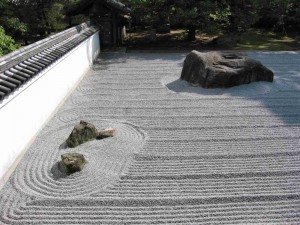Japanese language training can be frustrating and a little intimidating. When you listen to these audio lessons, please try to relax. Don’t worry too much about the transcript and the grammar guides. Those written materials are available to help you when issues arise, but just try to focus on whatever question you are being asked to answer in the moment. Having said that, it makes sense to scan the transcript and the Grammar Guide for useful clues before you start each lesson.
The transcript from the beginning of Lesson 1 is shown below. The information in parentheses is found only in the transcript; you will not hear this content voiced in the audio lesson.
Please click on the blue audio link below, and the lesson should start. After you hear the first question in English, pause playback. Take as much time as you need to think about the question. It’s OK to refer to the transcript if you need help with the answer. Then say your answer out loud.
Next resume playback in order to hear the correct answer. After listening to the answer, pause playback again. Compare the correct answer to the answer you said out loud. If you wish, repeat your answer, trying to match your pronunciation to that of the Japanese speaker. When you are ready, resume playback again to move on to the next question.
If you click on the following blue bar, you should be able to listen to the audio track for the beginning of Lesson 1:
[ddownload id="5988" text="Lesson 1, Part 1"] [ddownload_size id="5988"]
Abbreviated transcript for Lesson 1:

1. Please show the passport. Use the te or de form of the verb.
パスポートを見せてください。
Pasupooto wo misete kudasai.
(wo is used to show that the preceding term is a direct object) (some verbs have te forms, and others have de forms; misete is the ‘te’ form of the plain speech verb miseru = to show) (kudasai = ‘please’; kudasai is often preceded by the te or de form of a verb. Kudasai is the imperative form of kudasaru, a polite verb meaning ‘to honorably give,’ used when a person outside your in-group gives to you or to someone in your in-group. So this sentence could also be understood as ‘show the passport and honorably give,’ or ‘show the passport for me, would you?’)
2. Yes. In this context, this means ‘OK’ or ‘here you go.’
はい。
Hai.
3. It’s Michael Webb, huh.
マイケルウエッブさんですね。
Maikeru Uebbu san desu ne.
(san is an honorific term, similar to ‘Mr.’ or ‘Ms.,’ used after another person’s name) (desu means ‘it is’; its plain speech form is da) (ne is translated in these lessons as ‘huh’ or ‘right?’)
4. Yeah. It’s so.
ええ、そうです。
Ee. Sou desu.
5. Is it sightseeing, is it work? In this lesson, use kankou to mean sightseeing.
観光ですか、仕事ですか。
Kankou desu ka shigoto desu ka.
(cf. kenbutsu, also = ‘sightseeing’; cf. kankoku = ‘S. Korea’) (‘cf.’ means ‘compare’) (You will occasionally find suggested mnemonics in this transcript, written in italics. Here’s one for kankou: ‘when I was sightseeing, I saw canned corn‘) (ka is used to indicate ‘question mark’)
6. It isn’t sightseeing. It’s work. Use ja.
観光じゃありません。仕事です。
Kankou ja arimasen. Shigoto desu.
(Ja is the short form of dewa, used in the phrase dewa arimasen = ja arimasen = ‘something is not something else’; for example, ano hito wa baabarasan ja arimasen = ano hito wa baabarasan dewa arimasen = ‘as for that person over there, it is not Barbara.’) (Arimasu = the masu form of the plain speech verb aru = to exist. The masu form is more polite than the plain speech form. Arimasen is the negative form of arimasu; by itself, it means ‘doesn’t exist.’ However,when arimasen is combined with ja or dewa, its meaning changes from ‘it doesn’t exist’ to ‘it isn’t something else.’)
7. Please open the suitcase.
スーツケースを開けてください。
Suutsukeesu wo akete kudasai.
(akete is the te form of akeru = ‘open’)

8. Yes, go ahead.
はい、どうぞ。
Hai, douzo.
(douzo = ‘go ahead,’ sometimes translated as ‘please’; in this case it means ‘go ahead and look in my suitcase’)
9. As for this, what is it?
これは何ですか。
Kore wa nan desu ka.
(kore = ‘this,’ sore = ‘that,’ are = ‘that over there’) (nan = nani = ‘what’) [This sentence illustrates sentence pattern A: it begins with a noun or pronoun followed by wa (indicating a topic and translated as ‘as for’) and then goes on to ask a question about, or make a comment on, this topic. Please see the document Ga vs. Wa for more information. In this sentence, kore is the topic, and the subject is the silent pronoun ‘it.’]
10. Is it medicine?
薬ですか。
Kusuri desu ka.
11. No, it isn’t medicine. Use ja.
いいえ、薬じゃありません。
Iie, kusuri ja arimasen.
12. Well, what is it?
じゃ、何ですか。
Ja, nan desu ka.
(ja and dewa can also mean ‘well’)
13. It’s honey.
はちみつです。
Hachimitsu desu.
14. Show me please. ‘Me’ is understood.
見せてください。
Misete kudasai.